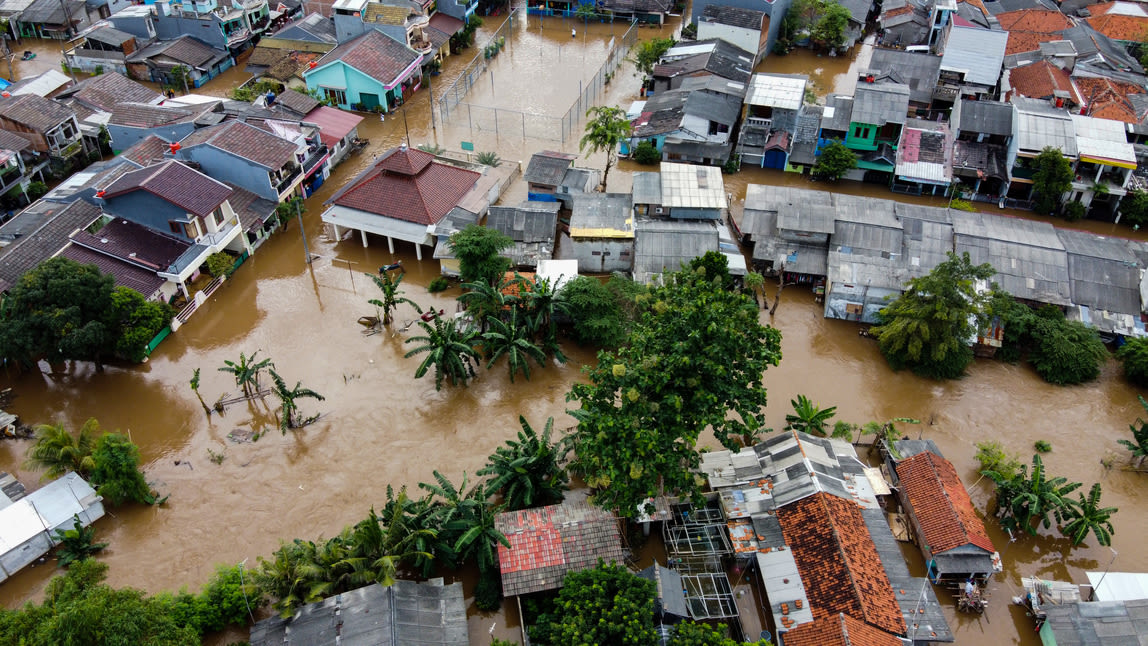This article presents a summary of findings from research carried out by the Foundation and Nordic Sustainability to understand the extent to which the circular economycircular economyA systems solution framework that tackles global challenges like climate change, biodiversity loss, waste, and pollution. It is based on three principles, driven by design: eliminate waste and pollution, circulate products and materials (at their highest value), and regenerate nature. is integrated into C40 cities’ climate strategies. In addition, it presents examples of circular innovation in key sectors, as well as city deep dives on San Francisco and Salvador illustrating how they are promoting circular economy innovation within their Climate Action Plans.
Lead author: Pippa Henderson, Policy Analyst, Ellen MacArthur Foundation
With thanks to colleagues and external experts who contributed
Cities are where the climate battle will be won or lost.
Patricia Espinosa, Executive Secretary, UNFCCC, 2016–2022
Home to 4.4 billion people worldwide and centres of resource use, cities are a concentrated representation of our current linear economic system, and account for 70% of all greenhouse gas (GHG) emissions globally. As the number of people living in urban areas rapidly increases – it is set to double by 2050 – so will urban emissions.
But it doesn’t have to be this way – cities have a huge opportunity to reduce emissions. City and local governments can use their soft powers (like awareness-raising campaigns) and hard powers (like regulation) to enable and accelerate local transitions in key areas such as transport, buildings and infrastructure, and waste systems. Along with other non-state actors, such as corporations and civil society organisations, they have a crucial part to play in driving climate action. To date, over a thousand cities around the world have committed to reaching net-zero emissions by 2050 as part of the UNFCCC’s global ‘Race to Zero’ campaign.
Achieving urban net-zero goals with the circular economy
As climate impacts escalate around the world, tackling emissions from fossil fuels by urgently transitioning to renewable energyrenewable energyEnergy derived from resources that are not depleted on timescales relevant to the economy, i.e. not geological timescales. and implementing energy efficiency measures is essential. But alone, these energy-related actions can only address 55% of emissions globally.
To complete the picture, we need to address the remaining 45% of global GHG emissions that are directly related to the way in which products, materials, and food are designed, produced, and used in our current extractive economy. Inger Anderson, Executive Director of the UN Environment Programme, cites this current linear production and consumption model as the “common thread” running through the triple planetary crisis of climate change, biodiversity loss, and waste and pollution. The bulk of these emissions are caused by industrial production processes, land use practices such as deforestation, and landfill and incineration, which are in turn driven by consumer demand.
45% of global greenhouse gas emissions can be attributed to the production of materials, products, and food, and to land management.
Image source: Ellen MacArthur Foundation, Completing the Picture: How the Circular Economy Tackles Climate Change
The circular economy offers cities three powerful principles which, when adopted together and underpinned by design, can help tackle these remaining emissions.
When we eliminate waste and pollution, we can reduce and avoid emissions across the value chain.
When we circulate products and materials, we can enable embodied emissions to be retained within the economy, and we get more value from resources used in their manufacture, such as materials, labour, and capital.
When we regenerate nature and natural systems, we can improve carbon sequestration.
The circular economy can also tackle the root causes of biodiversity loss, create jobs, build resilience that contributes to climate adaptation, and grow prosperity. For example, circular business models in the textiles industry could be worth USD 700 billion by 2030 – making up 23% of the global fashion market. At the local level, the circular economy can provide access to nutritious food, improve air quality and urban health, and create local jobs. By design, circular economy solutions should ensure an inclusive and ‘just transition’ that reduces inequalities within and between countries, and enhances the livelihoods and wellbeing of all involved.
The circular economy model also aligns with many actions for cities recommended by the Intergovernmental Panel on Climate Change (IPCC) in its latest summary report. For example, ‘supporting public transport and active mobility’ can reduce congestion caused by privately owned cars and thereby reduce wasted space and pollution, while ‘green/natural and blue infrastructure’ (elements like rivers, wetlands, trees, and parks) can regenerate nature in urban areas.
The IPCC report also emphasises the need for cities to address scope 3, or consumption-based, emissions, to achieve net-zero. While most cities target scope 1 and scope 2 emissions (those emitted directly within a city, and as a result of the electricity the city uses, respectively), few are addressing scope 3 emissions.[1] These emissions stem from the ongoing demand for materials, services, products, and food used within the city but whose production and/or waste emissions occur outside of a city’s jurisdictional boundaries.[2]
Addressing these less tangible emissions can be tricky, with challenges including varied and inconsistent data, additional administrative burdens, and lack of capacity, expertise and experience. Tackling scope 3 emissions requires a holistic solution, and the circular economy offers cities an effective way to do so by prompting new practices such as sharingsharingThe use of a product by multiple users. It is a practice that retains the highest value of a product by extending its use period., renting, and reusereuseThe repeated use of a product or component for its intended purpose without significant modification., which reduce overall consumption demand.
Circular economy in city Climate Action Plans: the state of play
As the circular economy is not only key to climate action, but also brings a multitude of other benefits, logically, it follows that circular economy activities should feature in cities’ Climate Action Plans (CAPs).[3] So, do they?
To determine the extent to which cities are currently using circular economy strategies to address climate change, let’s look more closely at the kinds of actions and pledges taken at a city level.
By analysing 54 CAPs published by C40 cities across six continents, research between the Ellen MacArthur Foundation and Nordic Sustainability revealed that most cities do not currently incorporate the circular economy in their CAP to a significant degree.[4]
Although the circular economy is directly mentioned in two-thirds of CAPs, this is almost always in relation to waste management initiatives, such as waste segregation, recycling, and reusing wastewater. This captures principle 2 (keep products and materials in use), but misses principles 1 (eliminate waste by design) and 3 (regenerate nature). Capturing energy from waste does not align with principle 2 and therefore does not fit within a circular economy.
Expanding the search to include all actions that align with circular economy principles, whether or not they directly reference the circular economy, found that most related actions focus on waste management or transport.
Just four out of the 54 CAPs studied (7%) have a high level of circular economy integration. Two of these cities – San Francisco and Salvador – are discussed in further detail in the city deep dives.
Degree of circular economy integration in city CAPs

The three principles of the circular economy prioritise the elimination of waste by design. Upstream thinking – in this case, redesigning city services and systems so that they don’t create waste in the first place – is essential. From a city government perspective, this means using urban policy levers such as economic incentives, financial support, regulation, and awareness raising to promote circular products and business models, support local and regenerative productionregenerative productionRegenerative production provides food and materials in ways that support positive outcomes for nature, which include but are not limited to: healthy and stable soils, improved local biodiversity, improved air and water quality., and shift consumer behaviour.
The results of the analysis indicate both a limited understanding and a misinterpretation of the circular economy framework.
It is worth noting that some cities have separately published climate adaptation/resilience, circular economy, zero-waste, and other related strategies, which were not considered in this analysis. However, the limited presence of holistic circular solutions in CAPs indicates a clear need for a better understanding of the circular economy and its benefits among city governments, as well as more consistent integration across city strategies.
Circular interventions offer a largely untapped potential to deliver on emissions reductions in cities. However, we need to ensure the enabling environment for circularity is fully understood in cities. If we do not, interventions will continue to focus on only parts of circularity and not be undertaken in an integrated manner, and as a result we will not maximise emission reduction potentials and other benefits.
Gino Van Begin, Secretary General, ICLEI – Local Governments for Sustainability
Pockets of urban circular innovation offer inspiration for climate action
While overall circular economy integration is low, some promising upstream measures can be identified among the plans, mostly in the transport, food, built environment, and consumer goods sectors. The following examples demonstrate where cities are starting to harness the opportunities of a circular economy, and can inspire other cities to do the same.

Transport
Increasingly, cities recognise that current linear practices in urban mobility such as high dependence on individual car ownership exacerbate congestion, pollution, and heat-island effects. Parked cars also take up valuable land area – on average, European cars are parked 92% of the time – and when they are in use, only one or two seats tend to be occupied. Developing diverse methods of transport, encouraging shared and active transport, and planning for transit-oriented and compact cities, are all ways of not only reducing emissions but also making better use of materials and urban land, easing pressure on some of the planetary boundaries, and generating better health and nature outcomes. As such, almost all city CAPs analysed mention transport initiatives that incorporate circular practices.
Examples
Buenos Aires
Buenos Aires is focusing a large part of its public transportation efforts on promoting cycling. This follows an initial expansion of bike lanes during the COVID-19 pandemic which proved the level of demand: along two of the most popular routes, overall bicycle trips increased by 350% and the number of female cyclists quadrupled. The city’s public bicycle system now provides a free and 24/7 accessible service to all citizens. Building on this success, the city is improving how bikes can be used in combination with other forms of transport, and putting in place sensor systems to collect cyclist data to inform future planning.
Seoul
Seoul is planning to create a Cycle Rapid Transit system, with highways built exclusively for cycling. Modelled on the Bus Rapid Transit system, the infrastructure will include bicycle stations, aiming to increase the number of public bikes to around 40,000 and ensure residents can access them within a five-minute walk.
New York City
New York City has pledged that by 2050, four out of every five trips taken will be on foot, bicycle, or public transport. To get there, the city is improving the subway and bus systems, expanding bike lanes and bike share schemes, and supporting shared mobility options, among other measures.
São Paulo
São Paulo plans to establish an electric vehicle sharing network through economic incentives, charging infrastructure, and modification of relevant land use and building legislations. The city also plans to establish a more efficient logistics system, in partnership with the private sector, that will incorporate a network of mini logistical terminals in central or high-demand areas, cargo consolidation and vehicle sharing, and more efficient routing and scheduling of deliveries. The hope is to reduce the number of trucks on roads, cut congestion and emissions, reduce costs, and improve mobility and productivity in logistics operations.

Built environment
The built environment – made up of the buildings, roads, infrastructure, and other human-made features of our surroundings – uses almost half the materials extracted globally every year. By reducing demand for steel, aluminium, cement, and plastic, applying a circular economy approach to the built environment could reduce global CO2 emissions from building materials by 38% by 2050, while improving resilience to supply chain disruptions and raw materials price volatility. Several emissions reduction efforts in cities around buildings and infrastructure align with circular economy principles.
Examples
Vancouver
Vancouver has set a target to reduce embodied emissions from new buildings by 40% by 2030, compared to a 2018 baseline. Its strategy to achieve this comprises four overarching actions:
Change the rules: require new buildings to use low carbon materials
Change the market: make it easier and less expensive to build with low-carbon materials
Change the culture: support building with low-carbon materials
Change the context: align complementary strategies and actions
Barcelona
Barcelona is a high-density, compact city. It is maximising its use of space while combating the effects of climate change by promoting green roofs, terraces, and walls – recognising their value to produce food, cool the city, and enhance biodiversity. Already it has commissioned studies on green roofs, published guides, and launched various government subsidies. Its new measures go further, including cataloguing existing and potential productive roofs and walls, creating technical guidelines for public buildings, and pushing for regulatory changes that allow for agricultural activity atop a wider range of building types.
Dakar
Dakar focuses many of its activities on generating income for populations vulnerable to the effects of climate change, including through the development of green infrastructure such as rainwater harvesting, stormwater drainage, wetlands, and green spaces. These measures also shore up community resilience to climate change.

Food and agriculture
Food is at the forefront of the climate debate, with good reason: the current linear food system accounts for a third of global greenhouse gas emissions. It is the primary driver of biodiversity loss and while 10% of the planet’s population goes hungry, almost one-third of the food produced is wasted. Supporting a circular economy food system is therefore one of the most powerful climate actions cities can take. Applying circular economy principles to the way we produce and manage food resources could cut emissions by 49% in 2050, reduce the impact on farm-level biodiversity by an average of 50% by 2030, and feed our growing population without depleting nature. Food and agriculture initiatives that apply circular economy principles can be found in many city CAPs.
Examples
Quezon City
Quezon City in the Philippines has established a food security task force to strengthen its urban agriculture initiatives. One flagship programme is “Joy of Urban Farming”, which supports communities to take part in sustainable urban farming through awareness campaigns and starter kits. Rooftop and vertical gardens can help cool the air (reducing energy needs), reduce food miles (and associated transportation emissions), and divert kitchen waste away from landfill through composting (reducing landfill emissions).
Austin
Austin has set a goal to “Ensure all Austinites can access a food system that is community-driven, addresses food insecurity, prioritises regenerative agriculture, supports dietary and health agency, promotes plant-based foods, and minimises food waste.” Its plans to achieve this include a certification programme for “pro-climate, pro-health options”, a subsidy scheme for local regenerative food producers that employ low-income communities and people of colour, as well as economic incentives for local food businesses that offer more plant-based menu choices.
Paris
Paris’ CAP includes several ambitious objectives on both the production and consumption sides for a circular food system in the Paris basin.
20% of viable agricultural land to use organic methods by 2030, 30% by 2050
50% of food consumed in Paris to be locally produced by 2030, 75% by 2050
50% reduction in food waste by 2025

Consumer goods
The consumer goods sector is another highly polluting industry. For example, to meet the current EU climate targets, the consumer goods industry must more than halve its carbon emissions by 2030. Integrating circular economy principles into every stage of the urban products system can not only reduce emissions but also eliminate waste and pollutants which are harmful to human health and nature, and enable wider access to products, among other benefits. For example, replacing single-use cosmetics bottles with refillable designs and business models to support them could reduce GHG emissions by up to 85%.[5] By promoting the circulation of products and materials within the local economy, and optimising supply chains to enable this, cities can have a considerable impact on the amount of virgin materials used and GHG emissions generated.
Examples
Salvador
Salvador’s public procurement policy will include certain criteria that will ensure suppliers that have circular practices are prioritised in public procurement processes. The criteria are: life cycle costs of materials, percentage of biodegradable materials/components, percentage of recycled or reused materials, and whether the company has provisions in place for reverse logistics.
Montreal
Montreal plans to promote collaboration. It is creating circular economy networks between businesses, vendors, and community organisations, and establishing innovation zones to facilitate collaboration and exchange. It also plans to conduct material flow analysis to identify opportunities for byproducts or waste outputs from one industry to become raw materials or inputs for another.
Rotterdam
Rotterdam is promoting the repair and reuse of consumer goods and building materials, including through an initiative to create a reuse centre where citizens can lend and borrow products.
Deeper integration of the circular economy is needed
These examples show us that circular economy aligned actions are starting to show up in the work that cities around the world are doing to address climate change. But to achieve the level of systems change required to reach climate targets, upstream interventions must be incorporated across a much broader range of sectors and strategies.
For example, most city CAPs do, to a greater or lesser extent, recognise the value of restoring nature for emissions reductions through initiatives that create green spaces or increase tree coverage. Within CAPs, few are turning this into opportunities for nature-based carbon sequestration through a regenerative approach to the production of food and materials. Similarly, while recycling is common, higher-priority ‘R’ strategies[6] such as repairrepairOperation by which a faulty or broken product or component is returned back to a usable state to fulfil its intended use. and remanufacturing that prevent waste from being generated in the first place, are found in very few city CAPs. Keeping resources in use for longer using these strategies allows more value to be captured and shared around cities and within communities, supporting an equitable transition.
To help identify further circular economy solutions for climate action, the Ellen MacArthur Foundation’s resources set out specific policy actions for cities to transform the built environment, transport, consumer products, and food sectors.
Built environment fact sheet: How to apply planning policies to use land effectively, support the looping of local material flows, and increase quality of life
Mobility fact sheet: How to create a circular mobility system that offers more choices, is shared, electrified, multimodal, and looped
Cities and circular economy for food report: How to source regeneratively and locally grown food, make the most of food, and design and market healthier food products
Products fact sheet: How to reduce barriers for businesses to adopt circular practices, and broaden citizen access to circular products
“Deep, rapid, and sustained reductions in greenhouse gas emissions would lead to a discernible slowdown in global warming within around two decades, and also to discernible changes in atmospheric composition within a few years”
IPCC Sixth Assessment Report
Cities are central to the fight against climate change. As they prepare or update their CAPs, cities have the power and ability to seed circular economy strategies throughout their entire economic system. In doing so, every single city – from New York to Quezon City – can help achieve the collective change that is so urgently needed to address the climate crisis.
City deep dives
A small number of cities are exemplary in incorporating upstream innovation and waste prevention opportunities across multiple sectors in their CAPs. In this section we explore two examples, examining the measures included as well as the unique context that has shaped the plan. Both cities have focused on equity and inclusion and take a holistic approach to action planning. However, it is worth cautioning that any action plan is only as good as its implementation, and noting that our analysis did not explore the extent to which these plans have been implemented in practice.

Climate Action Plan deep dive: reducing scope 3 emissions in San Francisco
San Francisco’s CAP does not directly refer to the circular economy, but upstream activities that align with the three principles can be found throughout the CAP and the city’s scope 3 target will further increase the imperative for circularity.
In California, the land area that is burned by wildfires each year has increased five-fold since 1971 and this urgency is reflected in the City of San Francisco’s latest climate action plan. Having reached its 2004 emissions reduction target six years ahead of schedule, mostly through energy measures including electrification and decarbonising electricity, its Climate Action Plan 2021 ramps up the ambition level by starting to account for scope 3 emissions, and prioritising actions with distributed and equitable social benefits.
What is it measuring?
Since 2008, San Francisco has been measuring scope 1 and 2 emissions. In April 2019, the city expanded its annual emissions accounting to include scope 3 through a consumption-based emissions inventory (CBEI) which estimated the emissions from producing, transporting, selling, using, and disposing of goods and services in San Francisco.
Read more about San Francisco
The CBEI tracked supply chains for these goods and services over the period 1990-2015, and classified emissions as occurring either inside San Francisco, outside San Francisco but inside the United States, or outside the United States. Combined, these gave a final “emissions demand” estimate which enabled the city to establish consumption-based emissions reduction targets to accompany the planned sector-based targets for 2030 and 2050:
1. Sector-based (scope 1 and 2):
By 2030, reduce sector-based emissions by 61% below 1990 levels
By 2040, reduce sector-based emissions by 90% below 1990 levels
2. Consumption-based (scope 3):
By 2030, reduce consumption-based emissions to less than 30 mtCO2e per household, equivalent to a 40% reduction compared to 1990 levels
By 2050, reduce consumption-based emissions to less than 10 mtCO2e per household, equivalent to an 80% reduction compared to 1990 levels
Addressing emissions along supply chains (scope 3) furthers the climate justice agenda by also reducing harmful pollution outside of a city’s own boundaries, rather than ‘outsourcing’ its emissions to other communities.
The initiatives to achieve these emissions reduction goals were decided after a detailed community engagement process. Strategies are structured into six ‘sectors’, five of which incorporate measures that relate to the circular economy.
1. Energy supply (no circular economy measures)
2. Responsible production and consumption
Reduce the carbon footprint of the food system by reducing waste, promoting climate friendly diets, and redistributing excess food to communities in need.
Promote reduction, reuse, repair, and recovery of goods and materials.
3. Transportation and land use
Create a complete and connected active transportation network that shifts trips from automobiles to walking, biking, and other active transportation modes.
Convert underutilised public and private parking lots, parking spaces, and garages to more productive uses, such as housing and car-free roads in parks.
Promote job growth, housing, and other development along transit corridors.
Strengthen and reconnect communities by increasing density, diversity of land uses, and location efficiency.
4. Building operations
Eliminate fossil fuel use in new construction.
Eliminate fossil fuel use in existing buildings by tailoring solutions to different building ownership, systems, and use types.
5. Healthy ecosystems
Advance city-wide collaboration to continually refine nature-based climate solutions that sequester carbon, restore ecosystems, and conserve biodiversity.
Restore and enhance parks, natural lands, and large open spaces.
Optimise management of the city’s entire urban forest system.
Maximise trees throughout the public realm.
Maximise greening and integration of local biodiversity into the built environment.
Conduct carbon sequestration farming pilot projects and research.
6. Housing
Preservation and rehabilitation of existing housing.
Advance zoning and implementation improvements that support new housing production sufficient to meet goals, especially sustainable, small, mid-sized, family, and workforce housing in lower density neighbourhoods.
The next steps of the CAP are to identify funding models for effective implementation of the planned actions, and to engage diverse communities around the city.

Climate Action Plan deep dive: circular economy aligned adaptation measures in Salvador
Salvador’s CAP consciously aims to promote a circular economy through supporting business innovation, while numerous other circular economy related actions contribute to the city’s climate adaptation priority.
Climate change poses significant risks to this coastal city in Brazil - like floods, sea level rise, heatwaves, and vector-borne diseases. This makes building resilience in vulnerable communities (those living in wetlands, hillsides and coastal areas, in poverty or on low incomes, among others) a natural focus of Salvador’s Climate Change Mitigation and Adaptation Plan.
The Plan was published in 2020 and was one of the first Latin American city CAPs to be approved by C40 as consistent with the goals of the Paris Agreement. Based on extensive public consultation, a vision was set to build an Inclusive, Blue-Green, Resilient and Low-Carbon Salvador by 2049. Each of these four components forms a strategic pillar, under which sit a number of actions selected not only for their feasibility and potential for mitigation and adaptation, but also the extent to which they can bring about positive changes in health, job creation, and environmental protection.
Read more about Salvador
The circular economy is directly integrated into the CAP within the Resilient Salvador pillar. Here, actions under the guiding theme "sustainable consumption" aim to develop circular innovations and businesses. This will be done through an information exchange platform; municipal circular economy hub and living lab; workshops, hackathons, and training; the creation of a mark to identify circular businesses; and circular public procurement.
Elsewhere in the CAP there are actions that don't directly refer to a circular economy but fit within the framework: local food production and the use of agroecological methods, expanding green spaces and tree cover will contribute to regenerating nature; while reusing water, waste segregation, and recycling will help to circulate products and materials at their highest value.
A number of these circular economy actions (highlighted with ✅ below) are also seen as generating adaptation benefits - improving the resilience of systems and communities to the effects of warmer climes, and providing solutions that will work in a world that is 1.5 degrees hotter.
1. Inclusive Salvador:
No circular economy activities.
2. Blue-Green Salvador:
Create and implement a payment programme for ecosystem services ✅
Expand urban afforestation ✅
Adopt blue-green infrastructure in city projects ✅
3. Resilient Salvador:
Encourage the adoption of circular economy principles in Salvador’s production chains
Launch the Be Circular Programme, an information exchange platform and workshop series to help start-ups and existing businesses to adopt circular economy principles. Sub-actions include creating a mark to identify circular businesses, organising circular economy hackathons, and providing training
Launch the Salvador Collaborative Platform
Encourage circular public procurement - with criteria including life cycle costs of materials, percentage of biodegradable materials/components, percentage of recycled or reused materials, and providing for reverse logistics
Launch a Municipal Circular Economy Hub for events, workshops, courses and mentorship programmes for businesses, and a living laboratory
Strengthen and expand the use of mechanisms to retrofit old or unoccupied buildings
Expand Urban Gardens and Orchards project
Foster organic urban agriculture
Launch calls for sustainable innovations on themes such as energy efficiency in public buildings, solar energy generation, and urban agriculture
4. Low-carbon Salvador:
Create and strengthen programmes to encourage active mobility
Expand and promote the use of the bicycle route network
Encourage a modal shift in transport including days when streets are free of cars and incentive programmes for cycling
Strengthen water resources management ✅
Expand separate waste collection ✅
Implement mechanisms to reduce waste generation and enhance separate waste collection for the public administration
Establish composting facilities and encourage composting ✅
Ensure that generate large volumes of waste contribute to the maintenance and costs of the municipal reverse logistics system and also play their part in the development of reuse systems ✅
Prevent dispersal of solid waste in neighbourhoods in order to avoid pollution of water bodies ✅
Encourage use and raise awareness of Green IPTU - a tax system providing both rebates for making properties more environmentally sustainable, and exemption for the portion of the property covered by native vegetation ✅
Encourage adoption of cool roofs ✅
Include ecosystem-based adaptation solutions in projects to upgrade buildings, public spaces and shading equipment ✅
The CAP discusses the need for evaluation at least once every four years, to ensure timely implementation, assess the effectiveness of the planned actions and adapt or create new actions as needed, with the participation of civil society and academic stakeholders. The city plans to set up a monitoring system and revision process, as well as a GHG Inventory Management Plan that can ensure emissions data are shared and optimised for the benefit of other departments and related initiatives in the city.
With thanks to experts for their contributions to the development of this article:
Simone Mangili, Executive Director, Carbon Neutral Cities Alliance
Magash Naidoo, ICLEI- Local Governments for Sustainability
Nordic Sustainability
Footnotes
[1]
According to 2022 analysis by the Ellen MacArthur Foundation and Nordic Sustainability, six cities have set specific scope 3 emissions reduction targets (Austin, London, Paris, Portland, San Francisco, Vancouver); other cities have pledged to reduce scope 3 emissions overall (Oslo, Stockholm) and others plan to address them in future iterations of their Climate Action Plans (Copenhagen, Sydney, Toronto)
[2]
For emissions accounting by cities, the GHG Protocol for Community-scale Greenhouse Gas Inventories distinguishes emissions based on where they occur. These are adapted from the scopes framework used in the Corporate Standard.
Scope 1: GHG emissions from sources located within the city boundary.
Scope 2: GHG emissions occurring as a consequence of the use of grid-supplied electricity, heat, steam and/or cooling within the city boundary.
Scope 3: All other GHG emissions that occur outside the city boundary as a result of activities taking place within the city boundary.
[3]
The Climate Action Plan (CAP) is “a document, or series of documents, in which a city sets out its roadmap for reducing GHG emissions and strengthening climate resilience across the community. A CAP is an important tool for driving forward better, faster and more ambitious initiatives. It communicates a city’s targets and key strategies, makes the case for action and demonstrates the link between climate action and the achievement of other city priorities. Crucially, by striving for a more inclusive and equitable city, it puts local people at the centre of the process.” C40, Why all cities need a Paris Agreement-compatible climate action plan (2020) https://www.c40knowledgehub.org/s/guide-home
[4]
The 2022 analysis first gathered all GHG emissions initiatives addressed in each CAP, identifying the emissions scopes (1, 2, 3), adaptation, sequestration, and sectors. Next, circular economy aspects of the CAP were mapped against 1) sectors, 2) the Ellen MacArthur Foundation’s Universal Circular Economy Policy Goals and 3) the ReSOLVE framework developed by McKinsey. It was also noted whether the city has a separate circular economy or zero waste plan in place. An overall assessment of the degree of circular economy integration in the CAP was then made.
[5]
Applying refillable designs and models to all bottles in beauty and personal care, as well as home cleaning, packaging and transport savings, would represent 80-80% GHG savings compared to single-use. Source: Ellen MacArthur Foundation, Completing the Picture (2021)
[6]
Morseletto (2019) expounds ten strategies to achieve circularity according to priority, starting with product design and manufacture (refuse, rethink, reduce), through consumer use (reuse, repair, refurbish, remanufacture, repurpose) to end-of-life (recycling, recovery).







